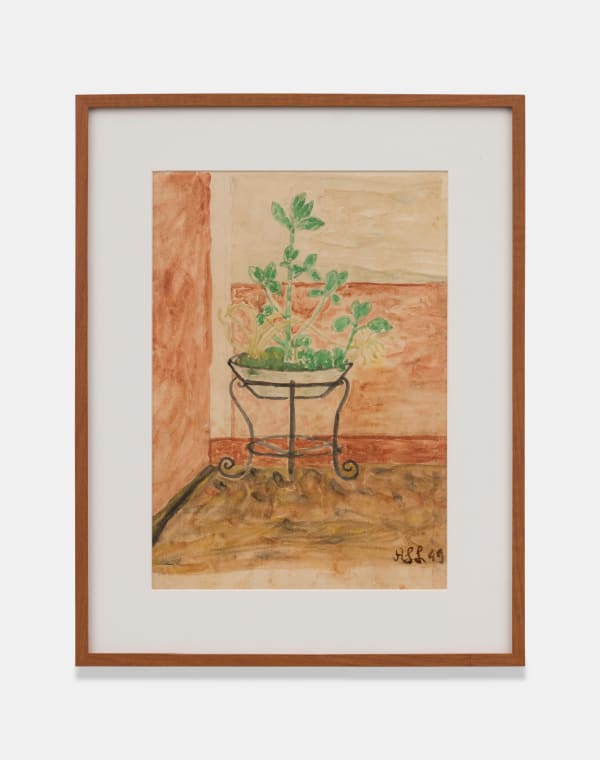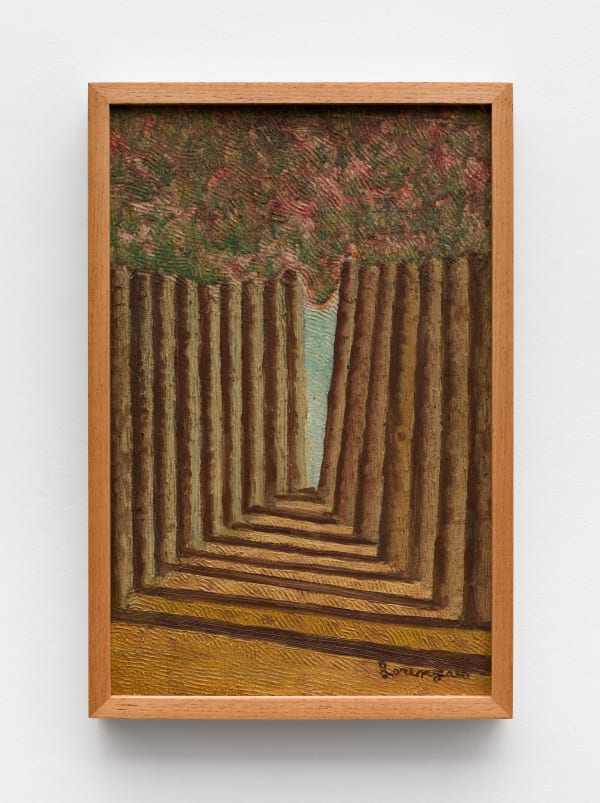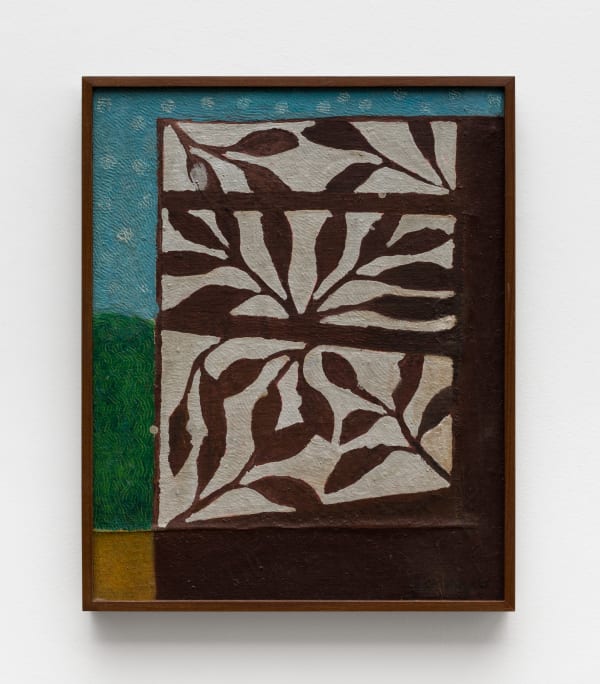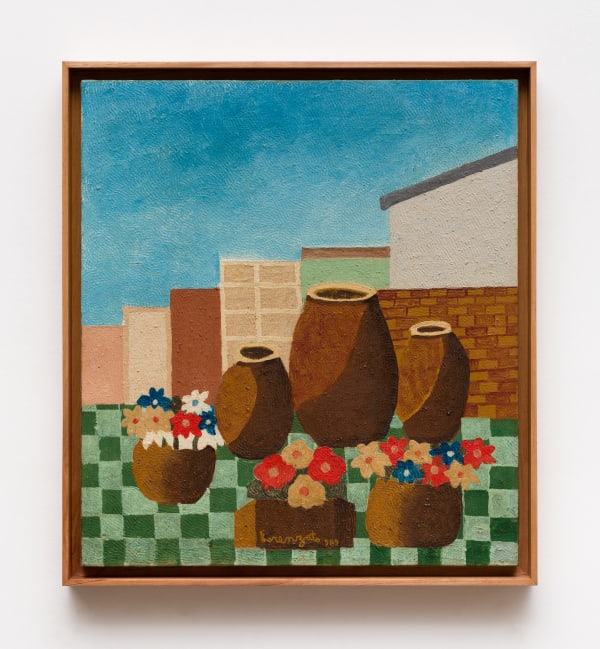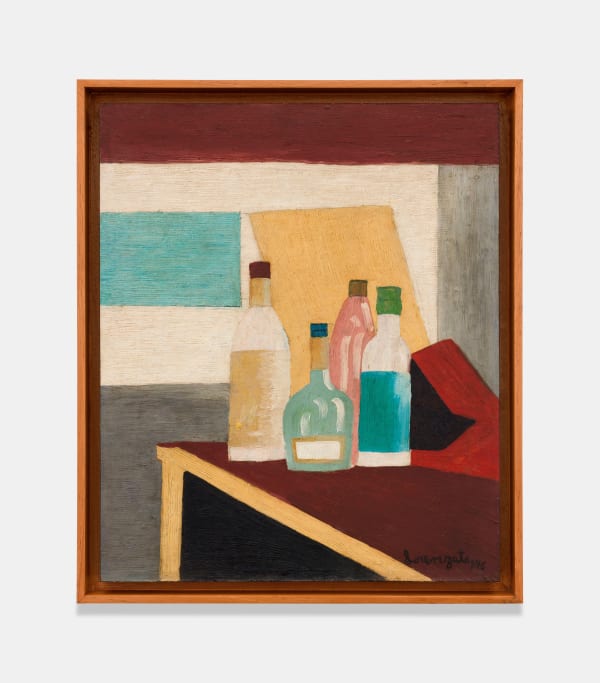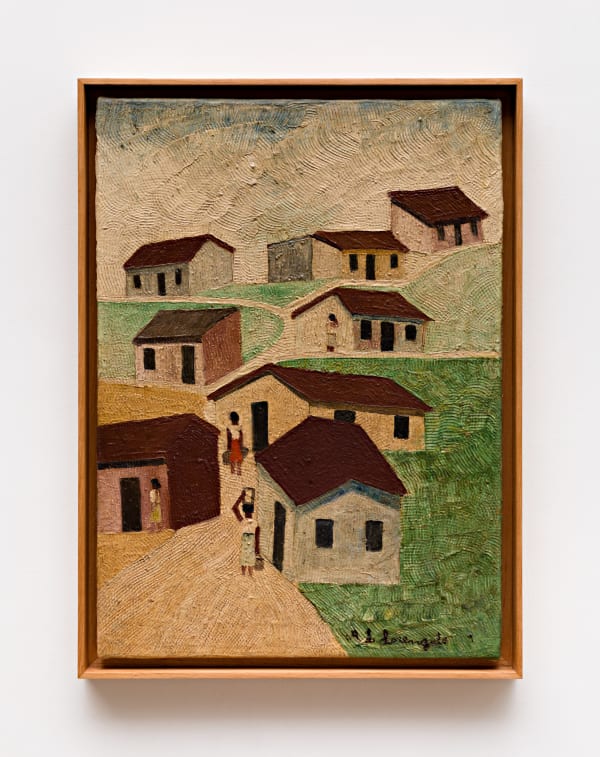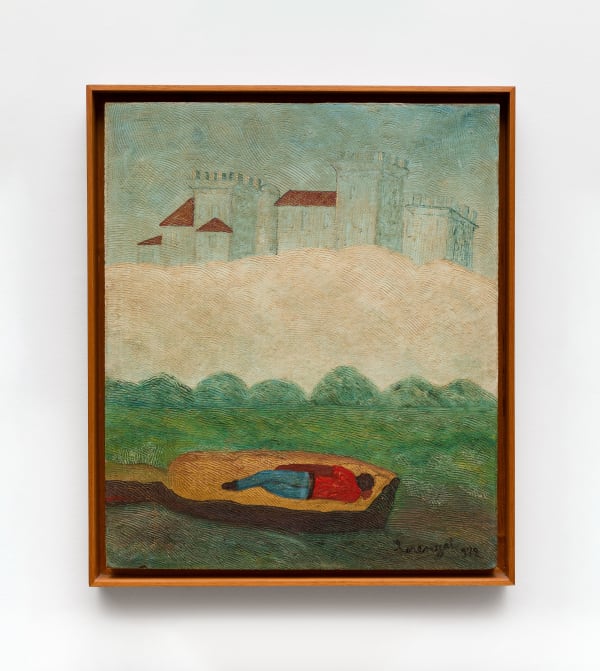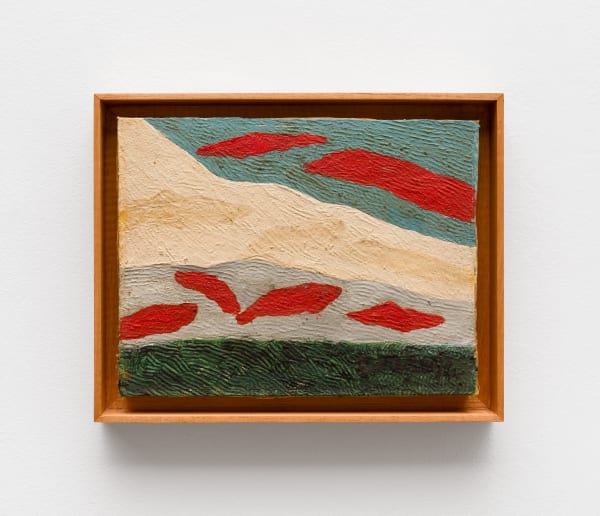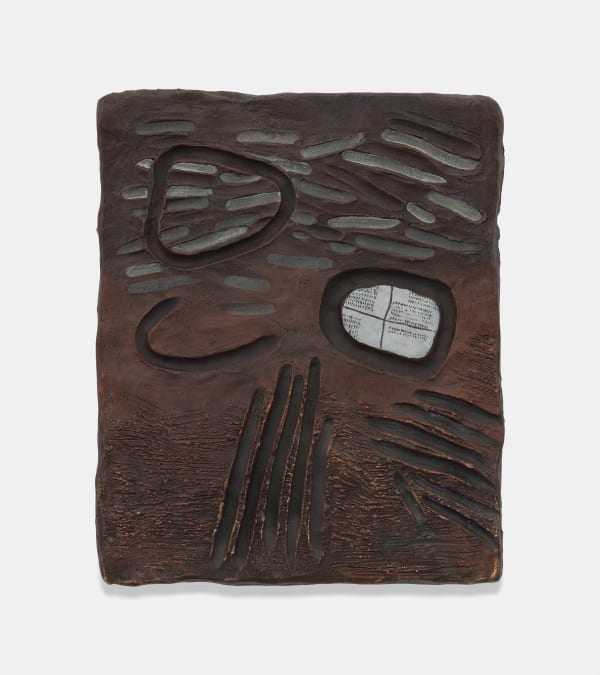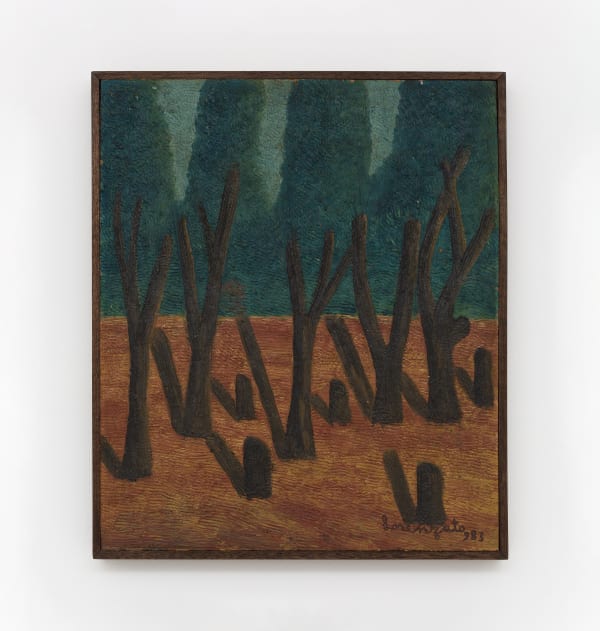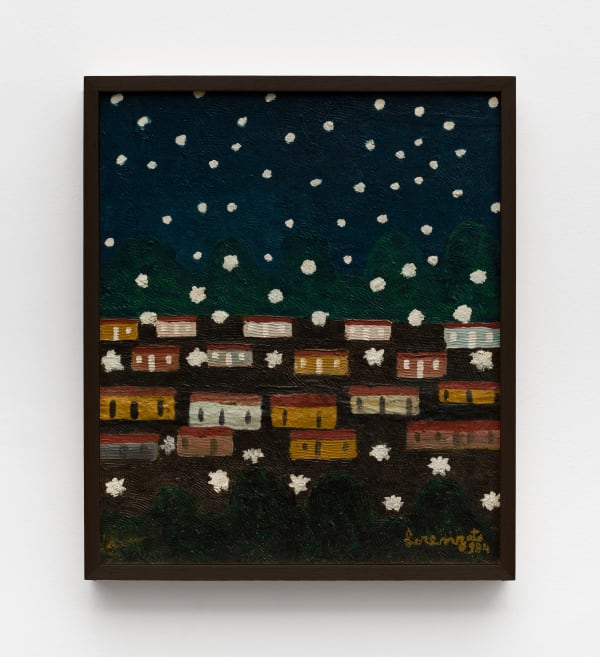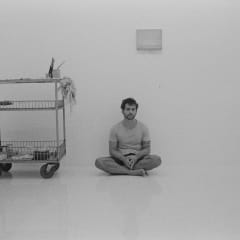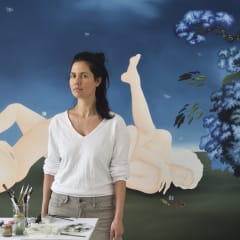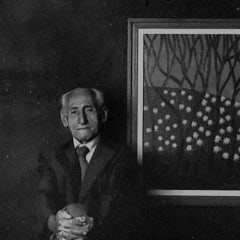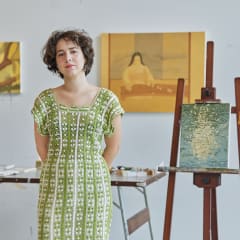Mendes Wood DM is proud to announce Amadeo Luciano Lorenzato En Conversation, a group exhibition in Paris that draws together works by Amadeo Luciano Lorenzato alongside contemporary artists Lucas Arruda, Sanam Khatibi, Patricia Leite, Paula Siebra, Marcos Siqueira, Erika Verzutti, and Castiel Vitorino Brasileiro.
Lorenzato, paints as he pleases
Amadeo Luciano Lorenzato painted what he saw around him. For over two-thirds of his long life he lived in Belo Horizonte, capital of the state of Minas Gerais in Brazil, near where he was born in 1900 to Italian immigrant parents. He took walks through the outskirts of the city, sketching the landscapes, the light and the natural world, the changing urban and industrial envi ronments, vernacular architectures, life in the favelas. Rendered from his memories of things seen and sketched, his works on the one hand distil sharp observations of a specific urban social experience and on the other are the fruit of constant experimentation with form, colour, paint application, pattern and composition. Stars merge with streetlights, trails made by slugs, birds and planes form dense mazes of sinuous lines, smoke billowing from chimneys morphs into brightly coloured Symbolist clouds, still-life arrangements scatter across the picture surface like Cubist compositions, landscapes and foliage veer towards abstraction. Artisanal in approach, he made his supports by hand, mainly using wood and board, and his paints using local Xadrez pigment powders made from iron dioxide. A unique technique of working the paint surface with a comb allowed the artist to create variations in colour and striations in the impasto, inspired by what he had learnt in his first métier as a decorative painter, executing marble or wood grain finishes. With combs and other implements, he achieved textures suggesting rough wall surfaces, effects of light on fields or rocky mountainsides, rainclouds massing on a flat white sky. Lorenzato painted constantly, with unwavering enthusiasm, and was prolific; it is estimated that he may have produced between 3000 and 5000 paintings, although many works have not been documented. In 1948, when he returned to Brazil after spending almost thirty years in Italy, he wrote on the back of a painting of butterflies in his garden: 'doesn't have a school, doesn't follow trends, doesn't belong to any chapel, paints as he pleases'.1
Never fitting into established frameworks – 'modernism' or 'primitivism' for example – Lorenzato's great stylistic freedom and ceaseless experimentation mean that he remains uncategorisable. The power of his artistic language is undeniable and, within his vibrant, pared back painterly expression that seeks to go to the heart of things, there is found a complexity of reflection along with a great richness of references. The celebration of colour, the search for new techniques, the breaking with artistic conventions — he was of his times, in the sense that he absorbed what was around him, both visually and in terms of ideas, and then used this in new ways, with the freedom to think and paint things together that are not generally associated. His work cuts across polarities – abstraction/figuration, high/low, old/new, erudite/popular, centre/periphery. In interviews, he spoke of Italian Renaissance painting as an important source for his work, mentioning Masaccio, Cimabue, Michelangelo, Leonardo da Vinci, but also more broadly church architecture and frescoes. At other times, he referenced with admiration painters of the late nineteenth and early twentieth centuries (Cézanne, Courbet, Van Gogh, Monet, Manet). 2 In his work we see Cézanne's study of volume and landscape, Van Gogh's impasto and the Impressionists' light. Matisse's love of colour and decorative motifs are another important point of reference. He called himself self-taught, although he did attend some classes when he was 25, during the time that he spent in Europe from 1929-1949. He lived mainly in Italy, but also travelled and worked for a period of nine months in Paris on the construction of the 1931 Exposition coloniale internationale. What is sure is that he was knowledgeable about European art history, keeping nearby a much leafed and underlined copy of Vasari, yet was far from the mainstream of the art system.3 Lorenzato was truly contemporary in the first sense that philosopher Giorgio Agamben outlines in his celebrated text What is the contemporary? (2008): 'Contemporariness is, then, a singular relation with one's own time, which adheres to it and, at the same time, distances itself from it.'4 It is, Agamben suggests, a disconnection and an out-of-jointness that characterises those who are truly contemporary in being able to perceive and grasp their own time specifically because they have not adjusted themselves to its demands and do not coincide with its contour.
Art historian Rodrigo Moura points to how the main body of Lorenzato's work, carried out in Belo Horizonte at a time of rapid urban change and industrialisation from the 1950s onwards, depicts in bold shapes and bright colours the city's 'marginal modernity, built on social injustice and unplanned urbanization'.5 This was also the period of the rise of modernism as the dominant framework in arts institutions in Brazil. As a working-class artist, Lorenzato was considered too common for the cultural and economic elites, or else was referred to as a 'primitive' painter. He started painting full time after a work accident in 1956, and in 1964 was given his first show at Minas Tennis Club. Moura speculates that the emerging Belo Horizonte art scene categorised his work as naïve in order to create a local version of the trope of cultivated modern connoisseurs discovering and appreciating the aesthetic value of the 'primitive'.6 He would subsequently be considered too erudite for a naïve artist, and was not included in survey exhibitions in Brazil that mobilised the categories of folk, naïve or primitive art. In the 1970s, he developed some notoriety amongst artists in Belo Horizonte's countercultural arts scene, and would continue to gain admiration from a broader circle of artists in the following decades, including those whose works have been placed in conversation with him in this exhibition. Senior contemporary artist Patricia Leite (b. 1955), like Lorenzato, plays between figuration and abstraction in her landscape and still life paintings. Her work in the exhibition, Festa no jardim (2023), explores the graphic qualities of foliage on the concave surface of a platter. Erika Verzutti (b.1971) is known for her particular colours and textures in sculptural and painted works that again blur lines between abstraction and figuration. Her painted bronze in the exhibition Rainy Night (2024) particularly resonates with Lorenzato's textured paint surfaces. It is the sublime rendering of light and of horizon lines between land and cloudy sky, moving towards abstraction, in the paintings of Lucas Arruda (b. 1983) that bring his work into dialogue with Lorenzato. Marcos Siqueira (b. 1989), painting the landscapes of Minas Gerais using natural pigments, playfully arranges colour and line to evoke quotidian moments on the canvas, like Lorenzato in his time. A younger generation of Brazilian artists under thirty, working with painting and in other media, have also discovered his work, including Castiel Vittorino Brasileiro (b.1996) and Paula Siebra (b. 1998). Outside of the Brazilian context Lorenzato's work is equally particularly appreciated by other artists, including Paris-based Sanam Khatibi, who herself approaches nature and landscape with a quite different set of questions.
Since Lorenzato's death in 1995, there have been significant changes in the positioning of modern and contemporary art in relation to other practices, geographies and histories, and the idea of art history as a single progression of conceptual developments linked to European and North American modernism has been largely superseded. Today we are seeing more complex formulations of the specificities and convergences between practices and aesthetic heritages — art histories in the plural — as well as a growing understanding of the multiple geographical, aesthetic, psychological and political contexts of artistic creation. This questioning of aesthetic categories and histories must continue to expand, notably through taking a fresh look at singular artistic practices like that of Lorenzato.
— Kathryn Weir *
*Kathryn Weir’s curatorial and writing practice engages with critical thinking on technology, class, race, gender and political ecology, focussing on intersections between theory, activism and artistic experimentation in the framework of contemporary art’s expanded geographies and histories. She was recently the Co-Artistic Director, Lagos Biennial 2021-2024, previously directing the MADRE museum in Naples (2020-23) and the multidisciplinary programmes at the Centre Pompidou (2014-20), where she created Cosmopolis, a platform for research-based, socially engaged and collaborative practices. From 2006-14, she was head of international art at the Queensland Art Gallery | Gallery of Modern Art (QAGOMA), Brisbane, and a member of the curatorium of the 5th, 6th and 7th Asia Pacific Triennials. Current and recent projects include Clément Cogitore: Ferdinandea (in 2025 at the Mucem, Marseille), Lagos Biennial 2024: refuge, And what if Carthage …? Nidhal Chamekh (Tunis, 2024), Green Snake: women-centred ecologies (Hong Kong, 2023-2024), Jimmie Durham: humanity is not a completed project (Naples, 2022-2023), Beauty and Terror: sites of colonialism and fascism (Naples, 2022), Claire Tabouret: I am spacious, singing flesh (Collateral Event, 59th International Art Exhibition – La Biennale di Venezia 2022), Rethinking Nature (Naples, 2021-2022), Temitayo Ogunbiyi: you will play in the everyday, running (Naples, 2020-2021), Utopia Dystopia: the myth of progress seen from the south (Naples, 2021- 2022), Collective Body (Dhaka Art Summit, 2020) and Cosmopolis #2: rethinking the human (Paris, 2019).
Publications include Beauty and Terror: sites of colonialism and fascism (2024), Rethinking Nature (2024), Utopia Dystopia: the myth of progress seen from the south (2023), Clément Cogitore: Ferdinandea (2023), Claire Tabouret: I am spacious, singing flesh (Mousse, 2022), Cosmopolis #1.5: enlarged intelligence(Centre Pompidou/ Mao Jihong Arts Fondation, 2018), Gorilla (Reaktion Books, 2013), Sculpture is Everything (QAGOMA, 2012), The view from elsewhere (Sherman Contemporary Art Foundation, 2009) and Modern Ruin (QAGOMA, 2008).
1 The full inscription on the back of the painting Untitled (1948) is 'Amadeo Luciano Lorenzato, pintor autodidata e franco atirador, não tem escola, não segue tendências, não pertence a igrejinhas, pinto conforme lhe da na telha. Amém'. See Rodrigo Moura, Lorenzato, KMEC Books, New York & Ubu Editoria, São Paulo, 2023, p.15. The author wishes to thank Rodrigo Moura for his important scholarship on the artist, on which this essay draws.
2 Rodrigo Moura, Lorenzato, KMEC Books, New York & Ubu Editoria, São Paulo, 2023, p.83.
3 Georgio Vasari, Le vite de' più eccellenti pittori, scultori, e architettori, Florence, 1568.
4 Giorgio Agamben, Che cos'è il contemporaneo? nottetempo, Rome, 2008, p.9.
5 Moura (2023), p.21.
6 Moura (2023), p.27
-
 Amadeo Luciano Lorenzato, Untitled, 1978
Amadeo Luciano Lorenzato, Untitled, 1978 -
 Amadeo Luciano Lorenzato, Untitled, 1977
Amadeo Luciano Lorenzato, Untitled, 1977 -
 Amadeo Luciano Lorenzato, Untitled, 1949
Amadeo Luciano Lorenzato, Untitled, 1949 -
 Amadeo Luciano Lorenzato, Untitled, 1986
Amadeo Luciano Lorenzato, Untitled, 1986 -
 Amadeo Luciano Lorenzato, Untitled, 1970
Amadeo Luciano Lorenzato, Untitled, 1970 -
 Amadeo Luciano Lorenzato, Untitled, 1992
Amadeo Luciano Lorenzato, Untitled, 1992 -
 Sanam Khatibi, I’ve officially lost vision, 2024
Sanam Khatibi, I’ve officially lost vision, 2024 -
 Amadeo Luciano Lorenzato, Untitled, 1962
Amadeo Luciano Lorenzato, Untitled, 1962 -
 Amadeo Luciano Lorenzato, Untitled, 1989
Amadeo Luciano Lorenzato, Untitled, 1989 -
 Patricia Leite, Festa no jardim, 2023
Patricia Leite, Festa no jardim, 2023 -
 Amadeo Luciano Lorenzato, Untitled, 1977
Amadeo Luciano Lorenzato, Untitled, 1977 -
 Amadeo Luciano Lorenzato, Untitled, 1976
Amadeo Luciano Lorenzato, Untitled, 1976 -
 Amadeo Luciano Lorenzato, Untitled, 1993
Amadeo Luciano Lorenzato, Untitled, 1993 -
 Amadeo Luciano Lorenzato, Untitled, 1950s
Amadeo Luciano Lorenzato, Untitled, 1950s -
 Amadeo Luciano Lorenzato, Le Penseur, 1972
Amadeo Luciano Lorenzato, Le Penseur, 1972 -
 Amadeo Luciano Lorenzato, Untitled, 1991
Amadeo Luciano Lorenzato, Untitled, 1991 -
 Erika Verzutti, Rainy Night / Nuit Pluvieuse, 2024
Erika Verzutti, Rainy Night / Nuit Pluvieuse, 2024 -
 Amadeo Luciano Lorenzato, Untitled, 1983
Amadeo Luciano Lorenzato, Untitled, 1983 -
 Amadeo Luciano Lorenzato, Untitled (from the Nocturnes series), 1984
Amadeo Luciano Lorenzato, Untitled (from the Nocturnes series), 1984 -
 Amadeo Luciano Lorenzato, Untitled, 1991
Amadeo Luciano Lorenzato, Untitled, 1991 -
 Paula Siebra, Cactos à noite, 2024
Paula Siebra, Cactos à noite, 2024 -
 Amadeo Luciano Lorenzato, Untitled (from the Nocturnes series), 1989
Amadeo Luciano Lorenzato, Untitled (from the Nocturnes series), 1989 -
 Lucas Arruda, Untitled (from the Deserto-Modelo series), 2022
Lucas Arruda, Untitled (from the Deserto-Modelo series), 2022 -
 Amadeo Luciano Lorenzato, Untitled, 1975
Amadeo Luciano Lorenzato, Untitled, 1975 -
 Castiel Vitorino Brasileiro, Sun House 1 | Casa do Sol 1, 2024
Castiel Vitorino Brasileiro, Sun House 1 | Casa do Sol 1, 2024 -
 Amadeo Luciano Lorenzato, Untitled, 1989
Amadeo Luciano Lorenzato, Untitled, 1989 -
 Amadeo Luciano Lorenzato, Untitled, 1985
Amadeo Luciano Lorenzato, Untitled, 1985 -
 Marcos Siqueira, Untitled, 2024
Marcos Siqueira, Untitled, 2024



